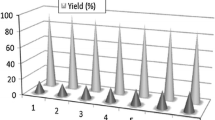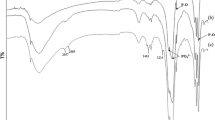Abstract
This research work describes the synthesis of copper incorporated hydroxyapatite encapsulated Kit-6 (Cu@HAp@KIT-6) as a novel and impactful nanocatalyst and evaluation of its activity in the synthesis of quinazoline derivatives by a three-component reaction of 2-amino-5-chlorobenzophenone, ammonium acetate, and aromatic aldehydes in ethanol. This practical method produced the products with high to excellent yields (85–96%) and reasonable reaction time (1 h). The nanocatalyst was characterized by Fourier transform infrared spectroscopy, X-ray diffraction, scanning electron microscope, energy dispersive analysis of X-rays, thermogravimetric analysis, differential thermogravimetric, and Transmission electron microscopy. The recyclability of the catalyst was also examined which preserved its main catalytic activity after six consecutive runs.




Similar content being viewed by others
References
Teng Q, Huynh HV (2015) Controlled access to a heterometallic N-heterocyclic carbene helicate. Chem Commun 51:1248–1251
Yan JM, Zhang XB, Akita T, Haruta M, Xu Q (2010) One-step seeding growth of magnetically recyclable Au@Co core−shell nanoparticles: highly efficient catalyst for hydrolytic dehydrogenation of ammonia borane. J Am Chem Soc 132:5326–5327
Decan MR, Impellizzeri S, Marin ML, Scaiano JC (2014) Copper nanoparticle heterogeneous catalytic ‘click’ cycloaddition confirmed by single-molecule spectroscopy. Nat Commun 5:4612–4619
Shokouhimehr M, Piao Y, Kim J, Jang Y, Hyeon TA (2007) Magnetically recyclable nanocomposite catalyst for olefin epoxidation. Angew Chem Int Ed 46:7039–7043
Yuan B, Pan Y, Li Y, Yin B, Jiang HA (2010) Highly active heterogeneous palladium catalyst for the Suzuki-Miyaura and Ullmann coupling reactions of aryl chlorides in aqueous media. Angew Chem Int Ed 49:4054–4058
Shylesh S, Schünemann V, Thiel WR (2010) Magnetically separable nanocatalysts: bridges between homogeneous and heterogeneous catalysis. Angew Chem Int Ed 49:3428–3459
Santos BF et al (2017) C-S cross-coupling reaction using a recyclable palladium prolinate catalyst under mild and green conditions. Chem Select 2:9063–9068
Zaera F (2010) The new materials science of catalysis: toward controlling selectivity by designing the structure of the active site. J Phys Chem Lett 1:621–627
Lee I, Albiter MA, Zhang Q, Ge J, Yin Y, Zaera F (2011) New nanostructured heterogeneous catalysts with increased selectivity and stability. Phys Chem Chem Phys 13:2449–2456
Bell AT (2003) The impact of nanoscience on heterogeneous catalysis. Science 299:1688–1691
Wang D, Astruc D (2014) Fast-growing field of magnetically recyclable nanocatalysts. Chem Rev 114:6949–6985
Zeng HC (2013) Integrated nanocatalysts. Acc Chem Res 46:226–235
Georgakilas V, Otyepka M, Bourlinos AB, Chandra V, Kim N, Kemp KC, Hobza P, Zboril R, Kim KS (2012) Functionalization of graphene: covalent and non-covalent approaches, derivatives and applications. Chem Rev 112:6156–6214
Gawande MB, Shelke SN, Zboril R, Varma RS (2014) Microwave-assisted chemistry: synthetic applications for rapid assembly of nanomaterials and organics. Acc Chem Res 47:1338–1348
Kondo JN, Domen K (2008) Crystallization of mesoporous metal oxides. Chem Mater 20(3):835–847
Hoffmann F, Cornelius M, Morell J, Froeba M (2006) Silica-based mesoporous organic-inorganic hybrid materials. Angew Chem Int Ed 45:3216–3251
Soler-Illia GJ, Sanchez C, Lebeau B, Patarin J (2002) Chemical strategies to design textured materials: from microporous and mesoporous oxides to nanonetworks and hierarchical structures. Chem Rev 102:4093–4138
Slowing II, Vivero-Escoto JL, Trewyn BG, Lin VSY (2010) Mesoporous silicananoparticles: structural design and applications. J Mater Chem 20:7924–7937
Kleitz F, Choi SH, Ryoo R (2003) Cubic Ia3d large mesoporous silica: synthesis and replication to platinum nanowires, carbon nanorods and carbon nanotubes. Chem Commun. https://doi.org/10.1039/b306504a
Kim TW, Kleitz F, Paul B, Ryoo R (2005) MCM-48-like large mesoporous silicas with tailored pore structure: facile synthesis domain in a ternary triblock copolymer−butanol−water system. J Am Chem Soc 127:7601–7610
Dorozhkin SV (2008) Bioceramics based on calcium orthophosphates. Glass Ceram 64:442–447
Uddin MH, Matsumoto T, Ishihara S, Nakahira A, Okazaki M, Sohmura T (2010) Apatite containing aspartic acid for selective protein loading. J Dent Res 89(5):488–492
Akazawa T, Kobayashi M, Kodaira K (1997) A newly designed adsorbent prepared from hydroxyapatite originating from cattle-bones for chromatographic separation of albumin and lysozyme. Bull Chem Soc Jpn 70:2323–2329
Zahouily M, Abrouki Y, Rayadh A, Sebti S, Dhimane H, David M (2003) Fluorapatite: efficient catalyst for the Michael addition. Tetrahedron Lett 44:2463–2465
Zhang Y, Santos JD (2000) Crystallization and microstructure analysis of calcium phosphate-based glass ceramics for biomedical applications. J Non-Cryst Solids 272:14–21
Zhang Y, Li Z, Sun W, Xia C (2008) A magnetically recyclable heterogeneous catalyst: Cobalt nano-oxide supported on hydroxyapatite-encapsulated γ-Fe2O3 nanocrystallites for highly efficient olefin oxidation with H2O2. Catal Commun 10:237–242
Tsoncheva T, Ivanova L, Rosenholm J, Linden M (2009) Cobalt oxide species supported on SBA-15, KIT-5 and KIT-6 mesoporous silicas for ethyl acetate total oxidation. Appl Catal B 89(3–4):365–374
Alam S, Anand C, Logudurai R, Balasubramanian VV, Ariga K, Bose AC, Mori T, Srinivasu P, Vinu A (2009) Comparative study on the magnetic properties of iron oxide nanoparticles loaded on mesoporous silica and carbon materials with different structure. Micropor Mesopor Mater 121:178–184
Zhou L, Ren QJ, Zhou XF, Tang JW, Chen ZH, Yu CZ (2008) Comprehensive understanding on the formation of highly ordered mesoporous tungsten oxides by X-ray diffraction and Raman spectroscopy. Micropor Mesopor Mater 109(1–3):248–257
Zhang Z, Zuo F, Feng P (2010) Hard template synthesis of crystalline mesoporous anatase TiO2 for photocatalytic hydrogen evolution. J Mater Chem 20:2206–2212
Kim H, Cho J (2008) Hard templating synthesis of mesoporous and nanowire SnO2 lithium battery anode materials. J Mater Chem 18:771–775
Liu H, Wang G, Liu J, Qiao S, Ahn H (2011) Highly ordered mesoporous NiO anode material for lithium ion batteries with an excellent electrochemical performance. J Mater Chem 21:3046–3052
Xia Y, Dai H, Jiang H, Deng J, He H, Au CT (2009) Mesoporous chromia with ordered three-dimensional structures for the complete oxidation of toluene and ethyl acetate. Environ Sci Technol 43:8355–8360
Ma CY, Mu Z, Li JJ, Jin YG, Cheng J, Lu GQ, Hao ZP, Qiao SZ (2010) Mesoporous Co3O4 and Au/Co3O4 catalysts for low-temperature oxidation of trace ethylene. J Am Chem Soc 132:2608–2613
Haffer S, Waitz T, Tiemann M (2010) Mesoporous In2O3 with regular morphology by nanocasting: A simple relation between defined particle shape and growth mechanism. J Phys Chem C 114:2075–2081
Gierszal KP, Kim T, Ryoo R, Jaroniec M (2005) Adsorption and structural properties of ordered mesoporous carbons synthesized by using various carbon precursors and ordered siliceous P6mm and Ia3̄d mesostructures as templates. J Phys Chem B 109(49):23263–23268
Sakamoto Y, Kim T, Ryoo R, Terasaki O (2004) Three-dimensional structure of large-pore mesoporous cubic Ia3d silica with complementary pores and its carbon replica by electron crystallography. Angew Chem Int Ed 43:5231–5234
Wu Z, Meng Y, Zhao D (2010) Nanocasting fabrication of ordered mesoporous phenol-formaldehyde resins with various structures and their adsorption performances for basic organic compounds. Micropor Mesopor Mater 128:165–179
Shon JK, Kong SS, Kim JM, Ko CH, Jin M, Lee YY, Hwang SH, Yoon JA, Kim J (2009) Facile synthesis of highly ordered mesoporous silver using cubic mesoporous silica template with controlled surface hydrophobicity. Chem Commun. https://doi.org/10.1039/B811718G
Hu X, Zhao H, Wang Y, Liu Zh, Feng B, Tang Ch (2018) Synthesis and biological evaluation of novel 5,6-dihydropyrimido[4,5-f]quinazoline derivatives as potent CDK2 inhibitors. Bioorg Med Chem Lett 28(20):3385–3390
Patel H, Shirkhedkar A, Bari S, Patil K, Arambhi A, Pardeshi Ch (2018) Quinazolino-thiadiazoles as antimicrobial agents. Bull Faculty of Pharm Cairo Univ 56(1):83–90
Asif M (2014) Chemical characteristics, synthetic methods, and biological potential of quinazoline and quinazolinone derivatives. Int J Med Chem 2014:1–27
Ouyang Y, Zou W, Peng L, Yang Zh, Tang Q, Chen M, Jia Sh, Zhang H, Lan Zh, Zheng P, Zhu W (2018) Design, synthesis, antiproliferative activity and docking studies of quinazoline derivatives bearing 2,3-dihydro-indole or 1,2,3,4-tetrahydroquinoline as potential EGFR inhibitors. Eur J Med Chem 154:29–43
Panja SK, Dwivedi N, Saha S (2012) I2-Catalyzed three-component protocol for the synthesis of quinazolines. Tetrahedron Lett 53(46):6167–6172
Derabli C, Boulcina R, Kirsch G, Carboni B, Debache A (2014) A DMAP-catalyzed mild and efficient synthesis of 1, 2-dihydroquinazolines via a one-pot three-component protocol. Tetrahedron Lett 55(1):200–204
Dabiri M, Salehi P, Bahramnejad M (2010) Ecofriendly and efficient one-pot procedure for the synthesis of quinazoline derivatives catalyzed by an acidic ionic liquid under aerobic oxidation conditions. Synth Commun 40:3214–3225
Fujii A, Matsuo H, Choi J-C, Fujitani T, Fujita K-I (2018) Efficient synthesis of 2-oxazolidinones and quinazoline-2,4(1H,3H)-diones from CO2 catalyzed by tetrabutylammonium fluoride. Tetrahedron 74:2914–2920
Dadgar M, Milani Kalkhorani N (2014) [γ-Fe2O3-HAp-(CH2)3-NHSO3H] nanoparticles as a highly efficient and magnetically separable catalyst for green one-pot synthesis of 4(3H)-Quinazolinones. Int J Nano Dimens 6(5):473–478
Abdolmohammadi S, Shariati S, Elmifard N, Samani A (2020) Aqueous-Mediated green synthesis of novel spiro [indole-quinazoline] derivatives using kit-6 mesoporous silica coated Fe3O4 nanoparticles as catalyst. J Heterocyclic Chem 57:2729
Babaei B, Mamaghani M, Mokhtary M (2019) Sustainable approach to the synthesis of 1,4-disubstitued triazoles using reusable Cu(II) complex supported on hydroxyapatite-encapsulated α-Fe2O3 as organic–inorganic hybrid nanocatalyst. Reac Kinet Mech Cat 128:379–394
Mamaghani M, Sheykhan M, Sadeghpour M, Tavakoli F (2018) An expeditious one-pot synthesis of novel bioactive indole-substituted pyrido[2,3-d]pyrimidines using Fe3O4@SiO2-supported ionic liquid nanocatalyst. Monatsh Chem 149:1437–1446
Mamaghani M, Shirini F, Sheykhan M, Mohsenimehr M (2015) Synthesis of a copper (II) complex covalently anchoring a (2-iminomethyl) phenol moiety supported on HAp-encapsulated-α-Fe2O3 as an inorganic-organic hybrid magnetic nanocatalyst for the synthesis of primary and secondary amides. RSC Adv 5(55):44524–44529
Kheirkhah L, Mamaghani M, Yahyazadeh A, Mahmoodi NO (2018) HAp-encapsulated γ-Fe2O3-supported dual acidic heterogeneous catalyst for highly efficient one-pot synthesis of benzoxanthenones and 3-pyranylindoles. Appl Organomet Chem 32(2):e4072
Ahmadiazar M, Mamaghani M (2018) Synthesis of (2-iminomethyl)pyridine moiety supported on hydroxyl apatite-encapsulated-γ-Fe2O3 as an inorganic-organic hybrid magnetic nanocatalyst for the synthesis of thiazole derivatives under ultrasonic irradiation. Curr Org Chem 22(13):1326–1334
Li B, Yao Ch, Shi Y, Ye D, Wu J, Zhao D (2013) A facile strategy for the preparation of well-dispersed bimetal oxide CuFe2O4 nanoparticles supported on mesoporous silica. J Mater Chem A 1:6742–6749
Mohsenimehr M, Mamaghani M, Shirini F, Sheykhan M, Moghaddam FA (2014) One-pot synthesis of novel pyrido[2,3-d]pyrimidines using HAp-encapsulated-γ-Fe2O3 supported sulfonic acid nanocatalyst under solvent-free conditions. Chin Chem Lett 25(10):1387–1391
Jahanshahi P, Mamaghani M, Haghbin F, Nia RH, Rassa M (2018) One-pot chemoselective synthesis of novel pyrrole-substituted pyrido[2,3-d]pyrimidines using [γ-Fe2O3@HAp-SO3H] as an efficient nanocatalyst. J Mol Struct 1155:520–529
Mitsionis AI, Vaimakis TC (2010) A calorimetric study of the temperature effect on Calcium Phosphate precipitation. J Therm Anal Calorim 99:785–789
Galia CR, Lourenço LA, Rosito R, Souza Macedo CA, Quaresma Camargo LMA (2011) Physicochemical characterization of lyophilized bovin bone grafts. Rev Bras Ortop 46(4):444
Maleki B, Vedad Mofrad A (2016) Efficient synthesis of quinazoline derivatives catalyzed by flourinated alcohol. Res Chem Intermed 43(5):3111–3120
Acknowledgements
The authors would like to thank the Research Council of University of Guilan for partial financial support of this work.
Author information
Authors and Affiliations
Corresponding author
Additional information
Publisher's Note
Springer Nature remains neutral with regard to jurisdictional claims in published maps and institutional affiliations.
Supplementary Information
Below is the link to the electronic supplementary material.
Rights and permissions
About this article
Cite this article
Pirdelzendeh, D., Mamaghani, M., Shirini, F. et al. Copper incorporated hydroxyapatite encapsulated Kit-6 mesoporous silica as a novel and recoverable nanocatalyst for the synthesis of quinazolines. Reac Kinet Mech Cat 133, 441–454 (2021). https://doi.org/10.1007/s11144-021-02002-y
Received:
Accepted:
Published:
Issue Date:
DOI: https://doi.org/10.1007/s11144-021-02002-y




